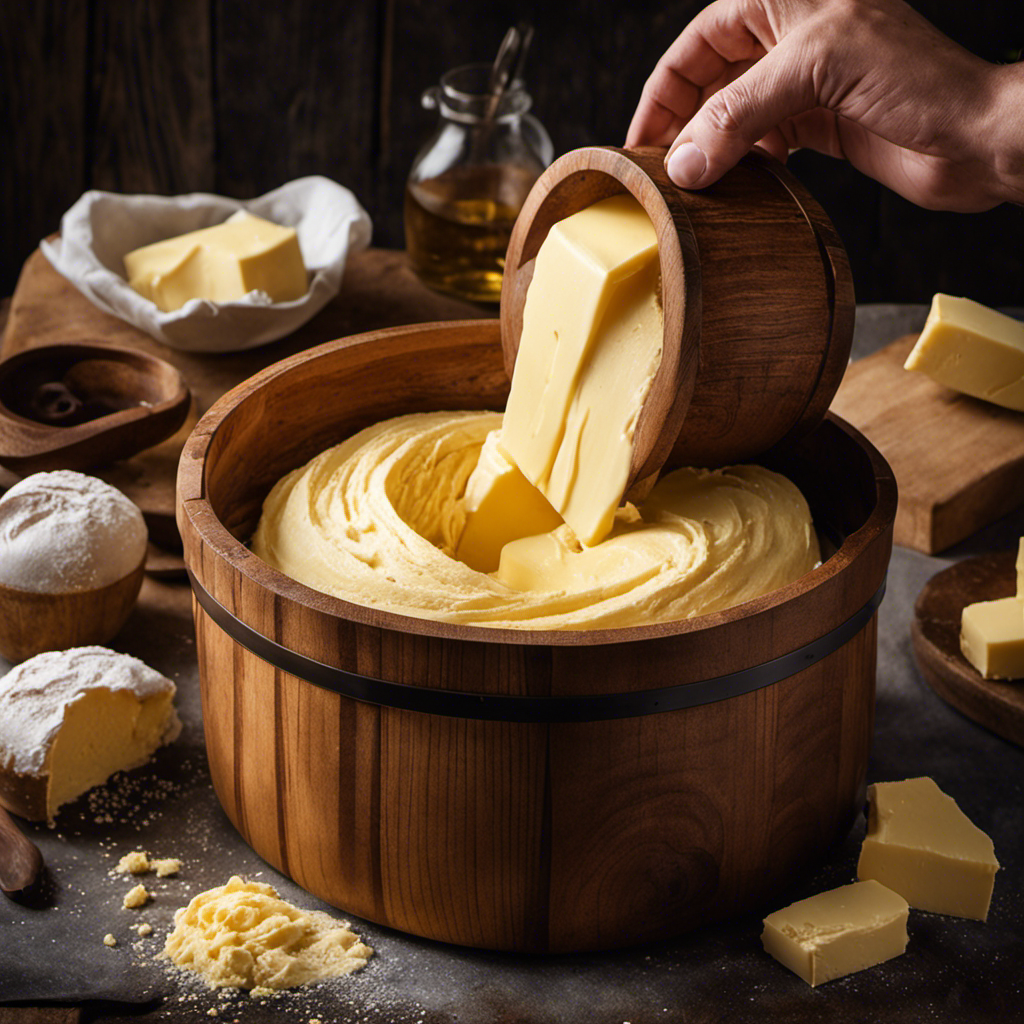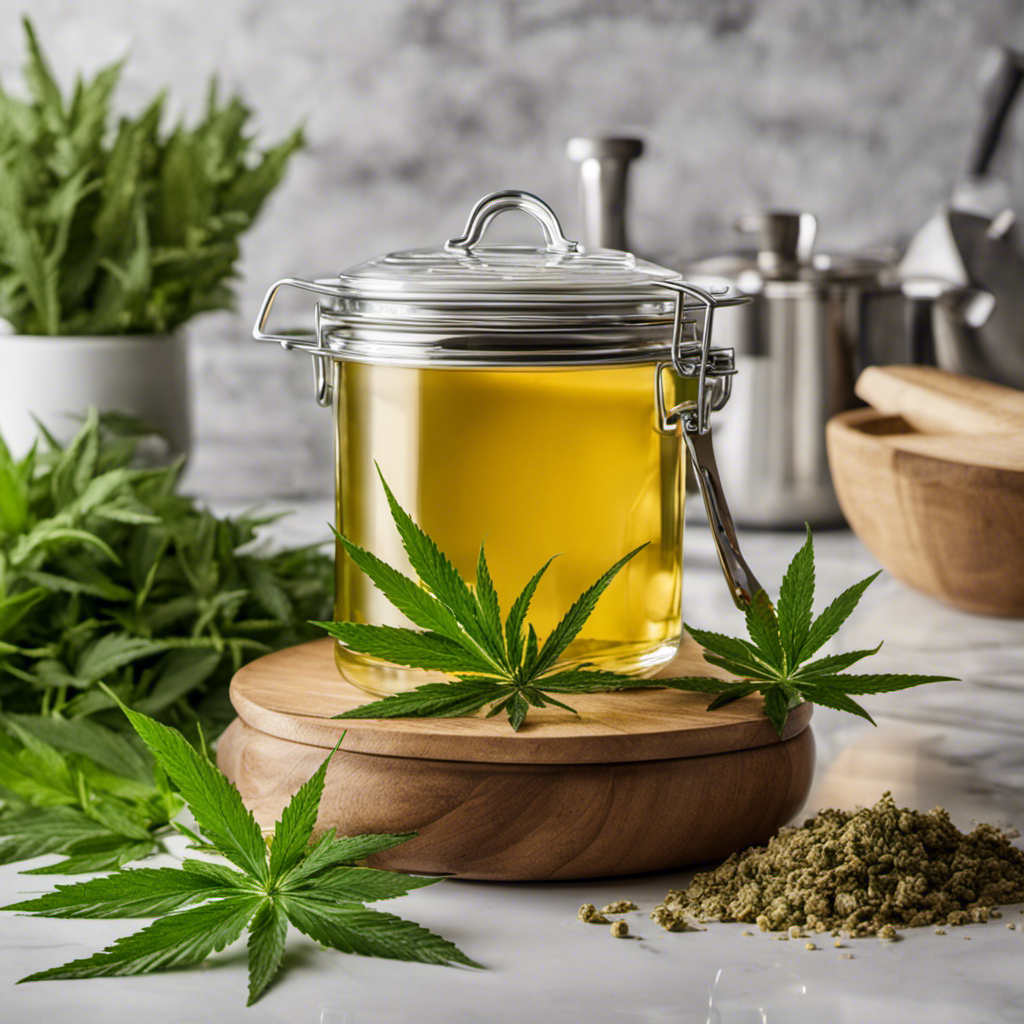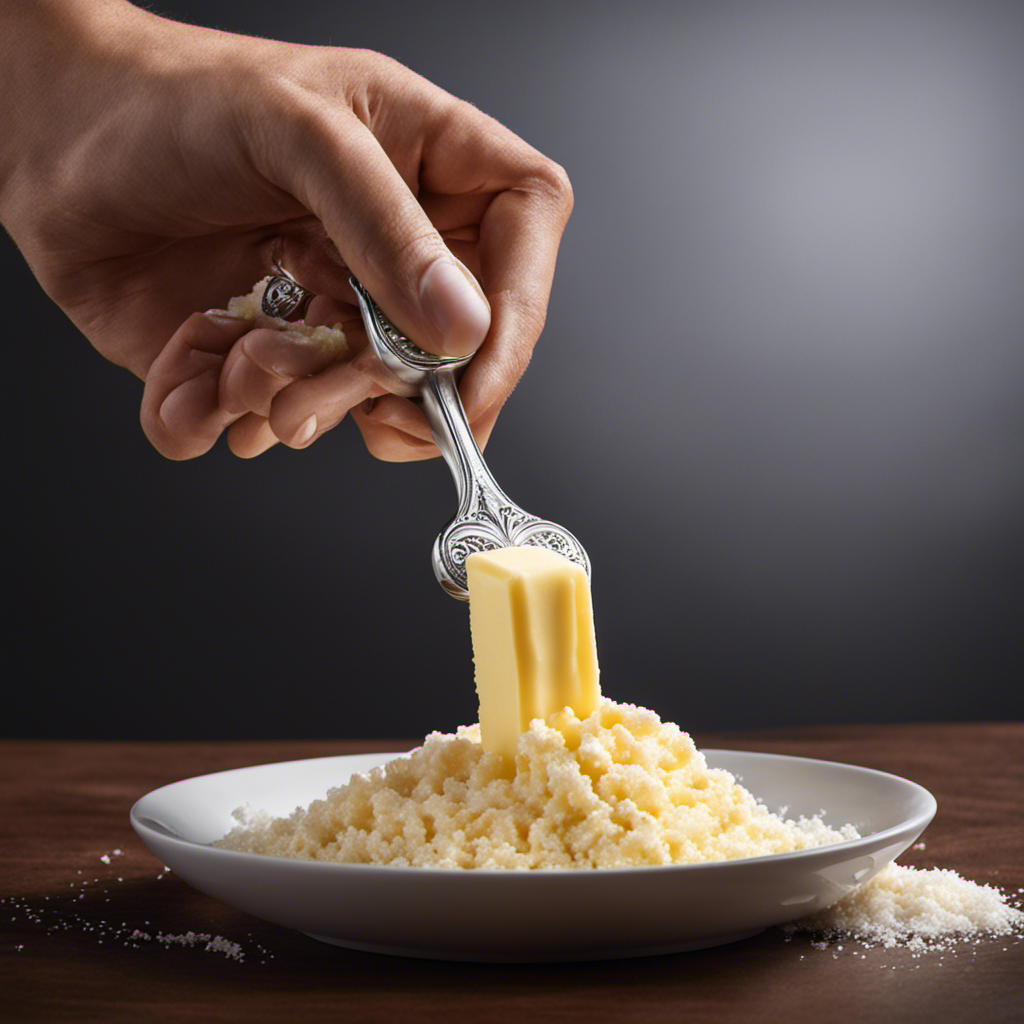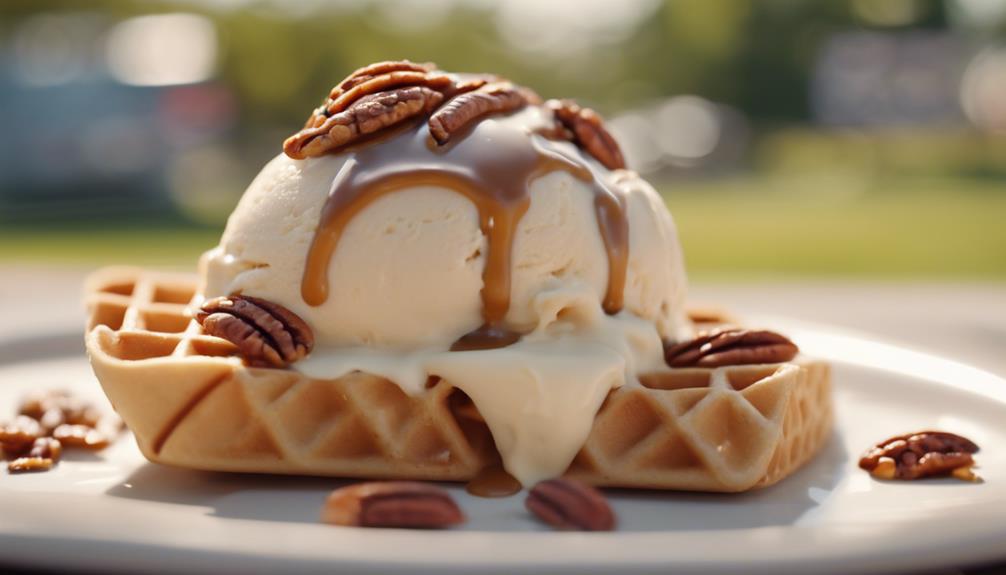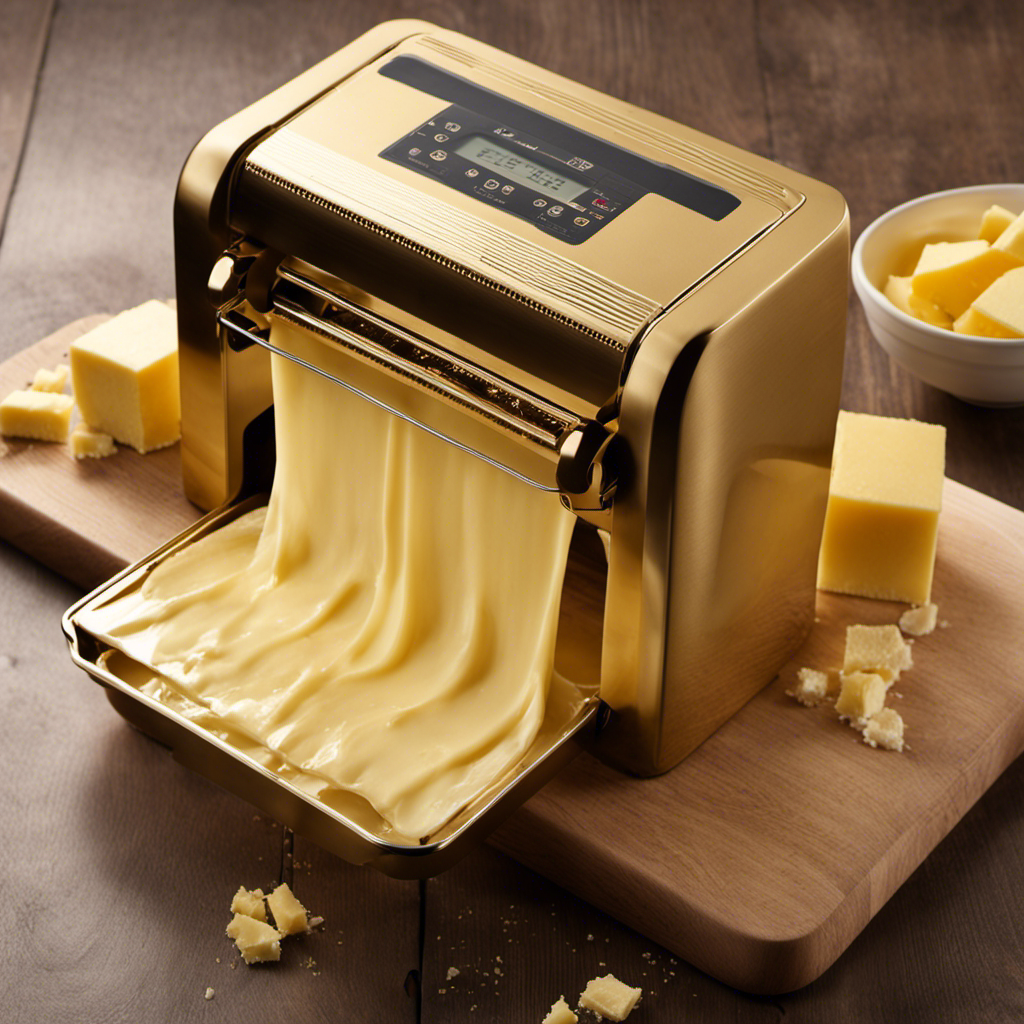I understand your thoughts: creating homemade butter may seem like a lengthy and complex procedure. However, believe me, it’s simpler than you may realize! In this article, I will walk you through the straightforward steps of making sweet cream butter from scratch.
By gathering the ingredients, churning the cream, separating the buttermilk, washing and kneading the butter, and optionally adding salt, you’ll have a delicious and creamy homemade butter that you can enjoy on toast, in recipes, or however you like!
Key Takeaways
- Choose high-quality whipping cream with at least 35% fat content
- Churn the cream at a temperature between 50-55°F until butter separates from buttermilk
- Strain the freshly churned butter and explore various uses for buttermilk in baking and cooking
- Properly knead the butter at room temperature and wash it thoroughly to remove buttermilk and impurities
Gathering the Ingredients
To make sweet cream butter, you’ll need to gather the necessary ingredients.
The first and most important ingredient is whipping cream. Make sure you choose a high-quality whipping cream with a fat content of at least 35%. This will ensure that your butter turns out rich and creamy.
Additionally, you’ll need a pinch of salt to enhance the flavor of the butter. Some people also like to add a bit of honey or maple syrup for a touch of sweetness.
As for equipment, you’ll need a stand mixer or a hand mixer with a whisk attachment. This will make the homemade butter process much easier and faster.
Churning the Cream
Start by pouring the cream into the churn and then turning the handle until it thickens. Churning the cream is a crucial step in making sweet cream butter.
The temperature plays a vital role in the churning process. Here are three key points to keep in mind:
-
Temperature: The cream should be chilled before churning. Cold cream helps the fat globules stick together and form butter faster. Aim for a temperature between 50-55°F for best results.
-
Patience: Churning takes time, and it may vary depending on the amount of cream and the churn you’re using. Be patient and keep churning until you see the butter separating from the buttermilk.
-
Troubleshooting: If the cream isn’t thickening, check if the temperature is too warm or if the churn is not working properly. Adjust the temperature or troubleshoot any mechanical issues before continuing.
Separating the Buttermilk
Once the butter has separated from the buttermilk, I strain it through a cheesecloth or fine-mesh sieve to remove any remaining liquid.
Now that I have my freshly churned butter, I can explore the various uses for buttermilk and consider alternatives if I don’t have any on hand.
Buttermilk is a versatile ingredient that adds a tangy flavor and tenderizes baked goods. It is commonly used in pancakes, waffles, biscuits, and cakes to enhance their texture and taste. Buttermilk can also be used as a marinade for meats, as it helps to tenderize and add flavor. Additionally, it can be used in salad dressings, dips, and even in smoothies for a creamy and tangy twist.
If you don’t have buttermilk, there are a few alternatives you can use. One option is to make your own by adding lemon juice or vinegar to regular milk and letting it sit for a few minutes until it curdles. Another alternative is using yogurt or sour cream mixed with a little milk to achieve a similar tangy flavor. These substitutes may not have the exact same consistency as buttermilk, but they can still provide a similar taste and texture to your recipes.
Washing and Kneading the Butter
When it comes to making butter, optimal kneading techniques and the importance of washing are crucial factors to consider.
Properly kneading the butter helps to develop its texture and ensure that it is smooth and creamy.
Additionally, washing the butter helps to remove any traces of buttermilk, which can affect its flavor and shelf life.
Optimal Kneading Techniques
To achieve the best results, it’s important to use proper kneading techniques when making sweet cream butter. The consistency of the butter and the duration of the kneading play a crucial role in achieving that perfect texture and flavor. Here are three key factors to keep in mind:
-
Consistency: The butter should be soft and at room temperature before kneading. This ensures that it will incorporate air properly and result in a light and fluffy texture.
-
Duration: Kneading should be done gently and for a sufficient amount of time. This allows the fat molecules to align, creating a smooth and creamy consistency. Over-kneading can cause the butter to become greasy.
-
Technique: Use your hands or a spatula to gently fold the butter back and forth. Avoid pressing or squeezing the butter too hard, as this can cause the fat to separate.
Proper kneading techniques are essential in achieving the desired butter consistency and texture.
Now, let’s move on to the importance of washing the butter.
Importance of Washing?
Now that we’ve learned about the optimal kneading techniques for making sweet cream butter, let’s discuss the importance of washing the butter.
After kneading the butter, it is crucial to rinse it thoroughly to remove any remaining buttermilk. This step is essential because buttermilk can cause the butter to spoil faster and develop off-flavors.
Rinsing the butter also helps to remove any impurities or unwanted particles that may have been introduced during the process. It ensures that the butter is clean and safe to consume.
When rinsing the butter, it is recommended to use cold water. This helps to solidify the butter and make it easier to handle. Cold water also aids in removing any residual buttermilk more effectively. Additionally, using cold water can help maintain the butter’s texture and prevent it from becoming too soft or mushy.
Overall, rinsing the butter with cold water is a crucial step in the butter-making process, ensuring a clean, safe, and high-quality end product.
Adding Salt (Optional
If you want to enhance the flavor of your sweet cream butter, you can add a pinch of salt. It may seem counterintuitive, but salt actually helps to bring out the natural sweetness of the butter.
Here are three alternatives to traditional table salt that not only add flavor but also provide health benefits:
-
Himalayan Pink Salt: Known for its high mineral content, this salt adds a subtle hint of earthiness to the butter. It also contains trace minerals like magnesium and potassium, which are essential for maintaining proper bodily functions.
-
Sea Salt: Harvested from evaporated seawater, sea salt has a slightly briny taste that complements the creamy richness of sweet cream butter. It is also minimally processed, retaining its natural minerals like calcium and iron.
-
Kosher Salt: With its coarse texture, kosher salt adds a delightful crunch to the butter. It is less salty than table salt, allowing you to control the seasoning more precisely. Additionally, kosher salt does not contain any additives or iodine, making it a healthier choice.
Storing and Enjoying the Homemade Butter
When it comes to storing homemade butter, proper storage is key to maintaining its freshness and flavor.
In this discussion, I will share some tips on how to store your butter correctly, ensuring that it stays delicious for longer.
Additionally, I will also explore some delectable butter pairings that can elevate your culinary creations to a whole new level of tastiness.
Proper Butter Storage
To maintain the freshness and quality of your sweet cream butter, store it in an airtight container in the refrigerator. Here are three options for butter dish containers that can help keep your butter fresh:
-
Butter Bell: This traditional French butter dish is made of two parts – a base that holds water and a lid that holds the butter. The water creates a seal, preventing air from reaching the butter and keeping it soft and spreadable.
-
Covered Butter Dish: A simple covered dish with a lid is another great option. Make sure the lid fits tightly to prevent air exposure.
-
Glass Jar with Lid: If you don’t have a designated butter dish, a glass jar with a tight-fitting lid can work well. Just make sure it’s clean and airtight.
Delicious Butter Pairings
To enhance your culinary creations, try experimenting with different butter pairings for a burst of flavor in your dishes.
Butter and cheese are a classic combination that can elevate any dish. The rich creaminess of the butter complements the sharpness of the cheese, creating a harmonious balance of flavors.
Spread some butter on a warm slice of crusty bread, and you have a simple yet satisfying snack. The butter adds a creamy texture and a hint of saltiness, enhancing the overall taste of the bread.
For a more indulgent treat, try making garlic butter to spread on your bread. The combination of butter and garlic creates a deliciously fragrant and savory flavor profile.
Frequently Asked Questions
Can I Use Any Type of Cream to Make Sweet Cream Butter?
Yes, you can use different types of cream to make sweet cream butter. However, using fresh cream is beneficial as it has a higher fat content and produces a richer, creamier butter.
How Long Does It Typically Take to Churn the Cream Into Butter?
It typically takes around 10-15 minutes to churn cream into butter. The temperature affects the churning process as colder cream takes longer to churn. Common mistakes to avoid include over-churning and using cream that is too warm.
What Can I Do With the Leftover Buttermilk After Separating It From the Butter?
After separating the buttermilk from the butter, there are many uses for it. Buttermilk can be used in baking, making pancakes or waffles, marinating chicken, or even making salad dressings. It adds a tangy flavor and helps tenderize food.
Is It Necessary to Wash and Knead the Butter After Separating the Buttermilk?
It’s not necessary to wash and knead the butter after separating the buttermilk, but it can improve the texture and flavor. Alternative methods for separating buttermilk include using a cheesecloth or a butter churn.
How Long Can I Store Homemade Butter and What Is the Best Way to Store It?
How long can I store homemade butter and what’s the best way to store it? Well, let me tell you, there are a few storage methods you can try, but it’s important to consider potential health risks.
Conclusion
In conclusion, making sweet cream butter at home is a simple and rewarding process. Gathering the ingredients, churning the cream, separating the buttermilk, washing and kneading the butter, and adding salt if desired are all steps that can be easily followed.
By following these steps, you can create your own delicious and creamy butter that is perfect for spreading on toast or using in your favorite recipes. So why not give it a try and impress your friends and family with your homemade butter?
It’s a coincidence that making butter is so easy, but the taste is no coincidence – it’s absolutely delicious!
